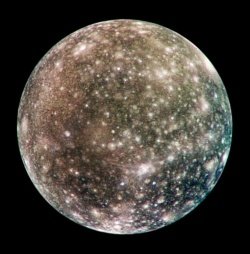Online Encyclopedia
Callisto (moon)
 Click image for description |
|||||||
| Discovery | |||||||
|---|---|---|---|---|---|---|---|
| Discovered by |
S. Marius G. Galilei |
||||||
| Discovered in | 1610 | ||||||
| Orbital characteristics | |||||||
| Mean radius | 1.883×106 km | ||||||
| Eccentricity | 0.007 | ||||||
| Revolution period | 16 day 16 h 32.2 min | ||||||
| Inclination | 0.281° | ||||||
| Is a satellite of | Jupiter | ||||||
| Physical characteristics | |||||||
| Mean diameter | 4820.6 km | ||||||
| Surface area | 7.2 ×107 km2 | ||||||
| Mass | 1.076×1023 kg | ||||||
| Mean density | 1.851 g/cm3 | ||||||
| Surface gravity | 1.24 m/s2 | ||||||
| Surface Gravity (Earth = 1) |
0.1265 | ||||||
| Rotation period | 16 day 16 h 32.2 min | ||||||
| Axial tilt | ° | ||||||
| Albedo | 0.20 | ||||||
| Surface temp. |
|
||||||
| Atmospheric characteristics | |||||||
| Atmospheric pressure | trace | ||||||
| Carbon dioxide | 100% | ||||||
Callisto is a moon of the planet Jupiter, discovered in 1610 by Galileo Galilei. It is the third-largest moon in the solar system, about the same size as the planet Mercury. It is named after Callisto, one of Zeus's many love interests in Greek mythology.
Although the name "Callisto" was suggested by Simon Marius soon after its discovery, this name and the names of the other Galilean satellites curiously fell into disfavor for a considerable time, and was not revived in common use until the mid 20th century. In much of the earlier astronomical literature, it is simply referred to by its Roman numeral designation as "Jupiter IV" or as the "fourth satellite of Jupiter".
Physical characteristics
Callisto is the most heavily cratered satellite in the solar system. In fact, impact craters and associated concentric rings are about the only features to be found on Callisto; there are no large mountains. This is probably due to the icy nature of its surface, with the largest craters and mountains being erased by the flow of the icy crust over geological time. Two enormous concentric ring impact basins are found on Callisto; Valhalla is the largest with a bright central region that is 600 kilometers in diameter and rings extending to 3000 kilometers in diameter, and the second-largest impact basin is Asgard measuring about 1600 kilometers in diameter. Another interesting feature is Gipul Catena , a long series of impact craters lined up in a straight line across Callisto's surface. This was probably caused by an object that was tidally disrupted as it passed close to Jupiter (much like Comet Shoemaker-Levy 9) before it impacted. Callisto's crust is thought to be approximately 4 billion years old, dating back almost to the formation of the solar system.
Its battered surface lies on top of an icy layer that is about 200 kilometers thick. Beneath the crust lies a salty ocean in excess of 10 kilometers thick. The ocean was discovered from studies of the magnetic fields around Jupiter and its moons. It was found that Callisto's magnetic field varies (flows in various directions at different times) in response to the background magnetic field generated by Jupiter; this suggests a layer of highly conductive fluid within Callisto. Another piece of evidence supporting the existence of an ocean under Callisto's crust is the fact that the surface of the moon directly opposite the massive impact crater Valhalla shows no fracturing or disrupted terrain, as the antipodes to similar massive impacts on the Moon and Mercury do; a liquid layer would serve to damp out the seismic waves before they could travel through Callisto to focus on the opposite side of its crust.
Beneath the ocean, Callisto seems to have a strange interior that is not entirely uniform and does not vary dramatically. Galileo probe data suggest that the interior is composed of compressed rock and ice, with the percentage of rock increasing with depth due to partial settling of its constituents. Callisto has the lowest density of the four Galilean moons of Jupiter, only 1.86 g/cm3, and is about 40% ice and 60% rock/iron. Titan and Triton are probably similar in composition.
Callisto has a very tenuous atmosphere composed of carbon dioxide.
Unlike neighbouring Ganymede with its complex terrain, there is little evidence of tectonic activity on Callisto. While Callisto is very similar in bulk properties to Ganymede, it apparently has a much simpler geological history. The different geologic histories of the two has been an important problem for planetary scientists. "Simple" Callisto is a good reference for comparison with other more complex worlds and it may represent what the other Galilean moons were like early in their history.
Callisto orbits just outside Jupiter's main radiation belt.
See also
- List of craters on Callisto
- List of geological features on Callisto
- The asteroid 204 Kallisto
Callisto in Fiction and Film
- Kim Stanley Robinson's novel Blue Mars contains a description of a flourishing colony on Callisto.
- Jupiter Moon was a short-lived British attempt at making a space soap opera. It was set on a space university that orbited Callisto.
| Jupiter |
|---|
| Amalthea group | Io | Europa | Ganymede | Callisto | Themisto | Himalia group | S/2003 J 20 |
| S/2003 J 12 | Ananke group | Carme group | PasiphaŽ group | S/2003 J 2 |
| (see also: Jupiter's natural satellites) |
